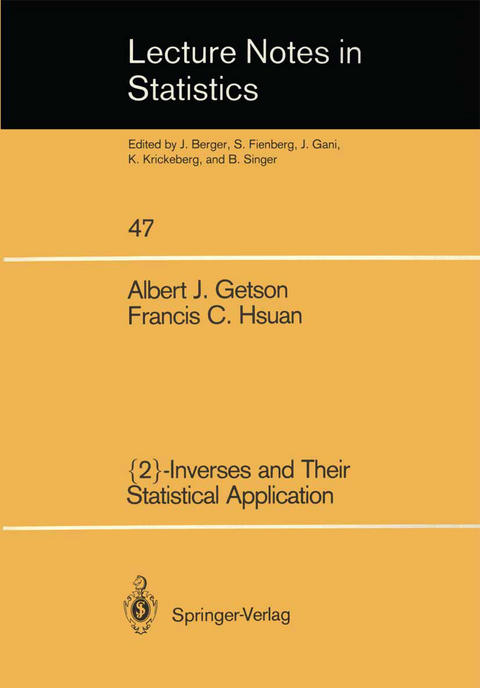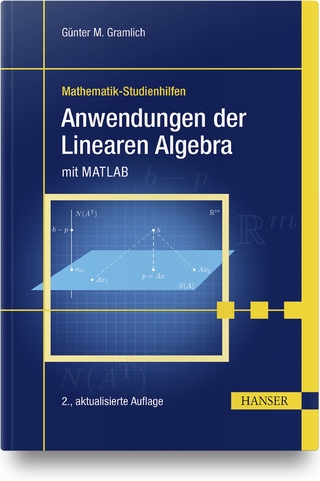
{2}-Inverses and Their Statistical Application
Springer-Verlag New York Inc.
978-0-387-96849-0 (ISBN)
Much of the traditional approach to linear model analysis is bound up in complex matrix expressions revolving about the usual generalized inverse. Motivated by this important role of the generalized inverse. the research summarized here began as an interest in understanding. in geometric terms. the four conditions defining the qnique Moore-Penrose Inverse. Such an investigation. it was hoped. might lead to a better understanding. and possibly a simplification of. the usual matrix expressions. Initially this research was begun by Francis Hsuan and Pat Langenberg, without knowledge of Kruskal's paper published in 1975. This oversight was perhaps fortu nate. since if they had read his paper they may not have continued their effort. A summary of this early research appears in Hsuan. Langenberg and Getson (1985). This monograph is a summary of the research on {2}-inverses continued by Al Getson. while a graduate student. in collaboration with Francis Hsuan of the Depart ment of Statistics. School of Business Administration. at Temple University. Philadelphia. The literature on generalized inverses and related topics is extensive and some of what is present here has appeared elsewhere. Generally. this literature is not presented from the point of view of {2}-inverses. We have tried to do justice to . the relevant published works and appologize for those we have either overlooked or possibly misrepresented.
I Introduction.- II Time for {2}-Inverses.- 2.0 Introduction.- 2.1 The Three Phase Inversion Procedure.- 2.2 Constrained Inverses.- 2.3 {2}- and {1,2}-Inverses: The Null Augmented Mappings.- 2.4 {1,5}-Inverses: The Nonnull Augmented Mappings.- 2.5 Construction of Moore-Penrose Type Generalized Inverses.- 2.6 A Geometric Representation of {2}-Inverses.- 2.7 {1,5}-Inverses and Projections.- 2.8 {1,5}-Inverses and Solutions to Linear Equations.- 2.9 Decomposition of {2}-Inverses.- 2.10 Spectral Decomposition in Terms of {2}Inverses.- 2.11 Computation of {2}-Inverses.- III {2}-Inverses, Quadratic Forms and Second Degree Polynomials.- 3.0 Introduction.- 3.1 x2 Distribution and Independence of Quadratic Forms and Second Degree Polynomials.- 3.2 Generalized Inverses and Quadratic Forms.- 3.3 {2}-Inverses and x2 Distributed Quadratic Forms.- 3.4 On The Uniqueness of the {2}-Inverse Representation of x2 Distributed Quadratic Forms.- 3.5 A Minimal Sufficient Set of Coefficient Matrices for All X2 Distributed Quadratic Forms.- 3.6 Independence of X2 Distributed Quadratic Forms.- 3.7 A Canonical Representation of Second Degree Polynomials.- 3.8 X2 Distributed Second Degree Polynomials.- 3.9 {2}-Inverses and the Distribution and Independence of Second Degree Polynomials.- IV {2}-Inverses and Least Squares Solutions.- 4.0 Introduction.- 4.1 The Least Squares Problem.- 4.1 Strategies For Obtaining Least Squares Solutions.- 4.3 Symmetric {1,2}-Inverses and Sets of Nonestimable Constraints.- 4.4 Bott-Duffin Inverses and Constrained LSS’s.- 4.5 {1,5}-Inverses and LSS’s.- 4.6 Relationships Among LSS’s.- 4.7 Minimum Norm LSS’s.- 4.8 A General Theorem on Constrained LSS’s.- 4.9 Residual Sum of Squares and Their Difference.- 4.10 Computing Constrained LSS’s and Residual Sum ofSquares.- V {2}-Inverses in Linear Models.- 5.0 Introduction.- 5.1 The Models.- 5.2 The Distribution and Relationships Among the LSS’s For the Prameters in Various Models.- 5.3 Hypothesis Testing in Linear Models.- 5.4 Equivalent Numerator Sum of Squares for a Test of Hypothesis.- 5.5 Hypotheses Invariant to Cell Sizes.- 5.6 The R Approach and SAS Type I and Type II Sums of Squares.- 5.7 The R* Approach and the SAS Type III Sum of Squares.- References.
| Reihe/Serie | Lecture Notes in Statistics ; 47 |
|---|---|
| Zusatzinfo | VIII, 110 p. |
| Verlagsort | New York, NY |
| Sprache | englisch |
| Maße | 170 x 244 mm |
| Themenwelt | Mathematik / Informatik ► Mathematik ► Algebra |
| Mathematik / Informatik ► Mathematik ► Statistik | |
| Mathematik / Informatik ► Mathematik ► Wahrscheinlichkeit / Kombinatorik | |
| ISBN-10 | 0-387-96849-0 / 0387968490 |
| ISBN-13 | 978-0-387-96849-0 / 9780387968490 |
| Zustand | Neuware |
| Haben Sie eine Frage zum Produkt? |
aus dem Bereich


